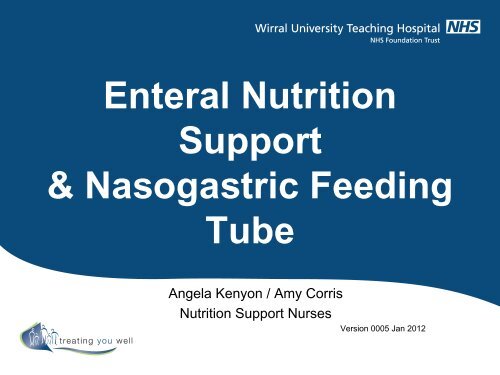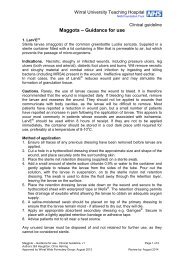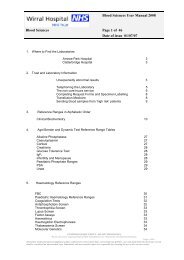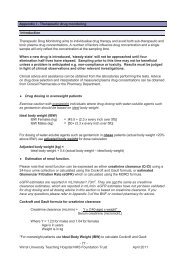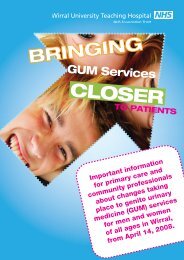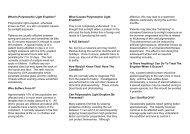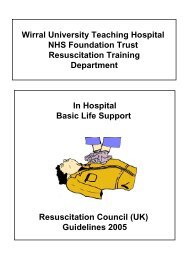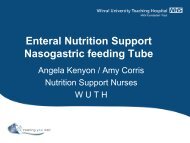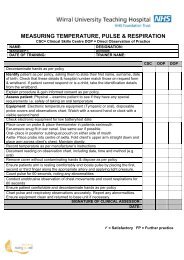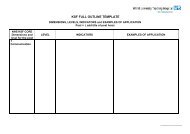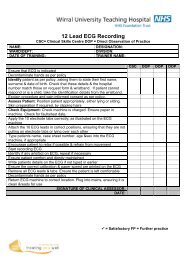NG Feeding Tube Training
NG Feeding Tube Training
NG Feeding Tube Training
You also want an ePaper? Increase the reach of your titles
YUMPU automatically turns print PDFs into web optimized ePapers that Google loves.
Enteral NutritionSupport& Nasogastric <strong>Feeding</strong><strong>Tube</strong>Angela Kenyon / Amy CorrisNutrition Support NursesVersion 0005 Jan 2012
Housekeeping• Welcome and registration• Fire Procedure• Facilities• Mobile Phones• Plan for session
Learning Outcomes• To develop the knowledge and skills requiredfor undertaking supervised practice in safeNasogastric tube insertion• To improve awareness of recent guidance onthe correct procedure of nasogastric feedingtube insertion.• To enable staff to gain competency.
Introduction• Whenever possible enteral access isthe preferred route.• Helps maintain mucosal integrity.• Reduces the risk of bacterialcolonisation and translocation.National Institute of Clinical Excellence (2006)
Assessment CriteriaMalnourishedor Enteralat riskInadequateor UnsafeOral IntakeA functionalaccessiblegastrointestinaltract+ + =Consider<strong>Tube</strong><strong>Feeding</strong>
Post Pyloric Placement of <strong>NG</strong> <strong>Tube</strong>• High risk of aspiration.• Gastric stasis - motility agent.• Upper gastrointestinal stricture.Post Pyloric positioning of tube must be conductedwithin interventional radiology
Enteral Access Devices
Ryles <strong>Tube</strong>
Fine Bore <strong>Feeding</strong> <strong>Tube</strong>
Nasogastric tube <strong>Feeding</strong>Advantages:• Less invasive than other methods.• Placed within the patient care environment orradiologically.• Supports the delivery of total nutritional needs,supplements inadequate oral intake without delay• Reduced risk of complications.
Nasogastric tube <strong>Feeding</strong>Contraindications:• Nasal injuries.• Base of skull fractures.
Safe Placement and ManagementThe patient:• Assessment to identify if <strong>NG</strong> feeding isappropriate.• Clear explanation of the procedure.• Patients role in supporting placement.• Gain verbal consent.
Safe Placement and ManagementWho should Place?• <strong>Tube</strong>s should be inserted by a healthcareprofessional with the relevant skills and training.(NICE 2006/NPSA 2011)• Placement requires skill and competence in orderto minimise risk including the number ofintubation attempts the patient has to undergo.(NPSA 2011)
Safe Placement and Management<strong>Tube</strong> Selection:• Fine bore polyurethane less than 9fr with guidewire.• Minimises the risk of Rhinitis, pharyngitis andoesophageal erosion.• 120cm in length to support post pyloricplacement.
Safe Placement and Management<strong>Tube</strong> Selection:• Radio opaque throughout their length.• Externally visible length markings.• Suitable placement for 4-6 weeks.
Safe Placement and ManagementEquipment:Bedsidedocuments +
Procedure• Position up rightsupported• Measure Nose, Earlobe & Xiphisternum(NEX).
Procedure• Introduce via eithernostril
Procedure• Negotiate pastepiglottis.
Procedure• Advance nasogastric<strong>Tube</strong> to stomach.
Procedure• Aspirate gastric juice.
Procedure• Test using pH graded paper ( CE marked).• Only flush with water and remove guide wirewhen the tip position is confirmed.
Procedure• Secure with fixationdevice.
Confirming <strong>Tube</strong> PositionOn Placement:• pH testing is the first line method with pHbetween 1 and 5.5 as the safe range.• Follow guidance on record of <strong>NG</strong> feeding tubeinsertion document.
Confirming <strong>Tube</strong> PositionX ray:• NPSA regarding no routine x rays.• Absence of a positive aspirate test.• pH readings more than 5.5 for nasogastricfeeding.• Post pyloric placement.
Unsafe Unreliable Methods• Whoosh test• Observing for air bubbles• Absence of respiratory distress• Blue litmus paper (The medicines and healthcareproducts regulatory agency 2004)
Care Following Safe Placement• must be flushed regularly to prevent buildup of feed and medication on the innerlumen using 30 -50 ml syringe
Care Following Safe PlacementFlushing:30 - 50 ml flush• before commencing feed• on completion• before and after administration of medication
Care Following Safe PlacementFlushing:10 - 15 ml flush• between each medication
Care Following Safe Placement<strong>Tube</strong> displacement after initial safeplacement can occur:• Mark tube at the nostril with indelible pen.• Measure length of visible tube and document.• Check fixation tapes daily.
Care Following Safe PlacementRecheck pH:• Before administration of feed following a break orif bolus feeding.• Before the administration of drugs.• After episodes of vomiting, retching or coughing.• After the use of oropharyngeal suction.
Care Following Safe PlacementRecheck pH:• If the visible part of the tube has changed inlength.• If patient complains of feed reflux.• At least once daily during continuous feeds.
Post Placement IssuesDisadvantages:• Persistent removal by restless or confusedpatients.• <strong>Tube</strong>s placed at surgery/endoscopically/radiologically becomingdisplaced.• Home nutrition.
Nasal Loop or Bridle
Nasal Loop
Nasal Loop or BridleIndications for Use:• Patient has displaced 2 feeding tubes within 48hours.• Electively for endoscopically single lumen feedingtubes.• Electively for x-ray guided placement.• Electively for some surgical procedures.
Nasal Loop or BridleAdvantages of Bridle:• May avoid more invasive access.• Supports delivery of full nutrition withoutdisruption.• Avoids further difficult placement.• Reduces the need for parenteral support.
Nasal Loop or BridleContraindications:• Patient refusal.• Severe trauma to face, nose or skull fracture.• Mechanical obstruction in the nasal airway.
References• National Institute of Clinical Excellence (2006)• National Patient Safety Agency (2011)• NHS National Patient Safety Agency. (2005) “Reducing the harm caused by misplacednasogastric feeding tubes”.• Baxa. (2007). NPSA Alert #19 Compliance Guide• Department of Health. (2006) Saving Lives: High Impact Interventions No.1.“Preventing the risk of microbial contamination.• Dougherty, L. & Lister, S. (2004). The Royal Marsden Hospital Manual of ClinicalNursing Procedures. (6th Edition) pp, 431-432.• Rollins, H. (1997). A nose for trouble. Nursing Times, 93 (49), 66-7.• Payne-James, J. (1995). Enteral nutrition: tubes and techniques of delivery. In: ArtificialNutrition Support in Clinical Practice. London: Edward Arnold, pp. 197-213.• Burns, S. M., Martin, M., Robbins, V. et al (1995). Comparison of nasogastric tubesecuring method and tube types in medical intensive care patients. Am J Critical Care. 4(3), pp 198-203.
Thank you


